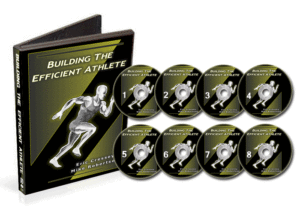Avoiding Tendinopathies by Reallocating Stress
Avoiding Tendinopathies by Reallocating Stress
In a previous newsletter, I wrote about how people become symptomatic for some musculoskeletal problem because numerous issues have collectively brought them to the threshold where pain kicks in. If you haven’t read it, definitely check it out now HERE.
Basically, the gist is that injury prevention and rehabilitation programs that only address single factors aren’t sufficient. You shouldn’t fix a shoulder problem with just rotator cuff strengthening exercises and rest. You can’t just get a massage and take some rest to get your lower back pain to go away.
In this newsletter, I highlighted how poor exercise technique – or even just faulty movement patterns in daily life – is something that can push someone to threshold. It’s one of the reasons why we go to such great lengths on our Building the Efficient Athlete DVD set to outline common technique mistakes and how to correct them with over 30 common resistance-training exercises.
One quick example of how this can push an athlete over the symptom threshold (or pull that athlete back under it) is kinesiotaping. In the past two years – and particularly at the Beijing Olympics – this modality spread rapidly in the world of athletics, treating everything from the ankles up to the shoulders.
While the creators of this tape assert that it has effects on the lymphatic and circulatory systems, it’s my impression that the most marked changes occur with respect to the reallocation of stress on particular tissues. I’ve perused all their reading materials, and nowhere do I see any claims that it reduces inflammation.
Here, then, we get support for the new (and correct) era of thinking that tendinitis is very uncommon. The -itis ending indicates an inflammatory condition, and if that was the case, some anti-inflammatories would quickly and easily take care of the overuse pain folks so commonly feel in the athletic world. Anyone who has struggled with an achilles, patellar, or supraspinatus tendinopathy will tell you that it really isn’t that simple, so what gives?
The truth is that most folks are dealing with a tendinosis. The -osis ending tells us that we’re dealing with a degenerative – not inflammatory – problem. Essentially, tissue loading exceeds tissue tolerance – and that means that we need to find a way to reallocate stress to ease the burden on that tissue both acutely (kinesiotaping) and chronically (appropriate movement patterns).
The difference between tendinitis and tendinosis has been highlighted at-length in the research world. Unfortunately, the correct terminology has been slow to catch on both in the medical community and lay population. As a result, many individuals underestimate the chronic nature of these problems.
In the photo above, a tape-job might help at the shoulder acutely by posteriorly tilting the scapula or altering the degree of humeral rotation to allow for safe overhead movements (less mechanical impingement of the rotator cuff on the undersurface of the acromion process of the scapula). Long-term, though, an athlete with this type of shoulder problem would need to work on scapular stability, glenohumeral range-of-motion, rotator cuff strength, and thoracic spine range-of-motion. And, of course, he’d need to ingrain these appropriate movement patterns with a resistance training program with perfect form.
Oh, and speaking of tendinopathies, it is only somewhat coincidental that I’m publishing this newsletter today: the day of the Boston Marathon. Thousands and thousands of runners who are at the brink of threshold are going to be piling 26.2 miles of volume on top of their glaring dysfunctions. I’m headed out to watch the best reality TV show in the world: the hip replacement docs in Boston are going to be busy for the rest of the week!
New Blog Content
Static Posture Assessment Mistakes: Part 3




